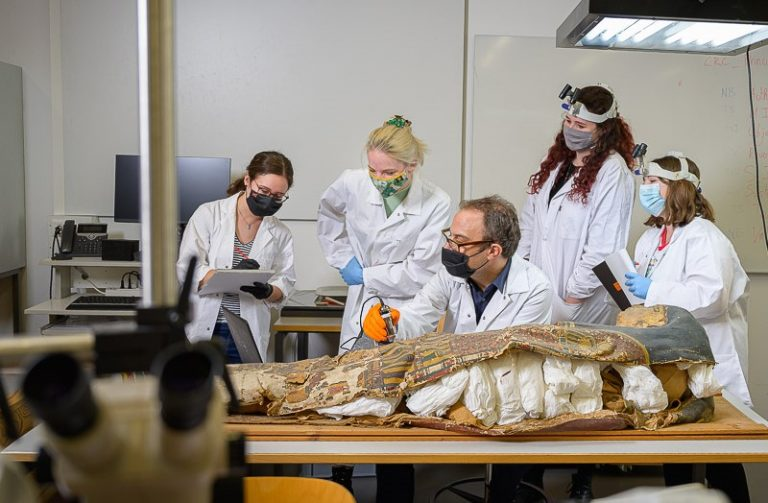The DOA project aims at studying and conserving the human remains and the painted cartonnage case of Ta-sherit-en-Imen (Amun’s little one). The mummy dates to the Third Intermediate Period (1069-664 BC) and was brought to the shores of Lago Majore by the Swiss collector Zaccaria Zanoli at the end of
Project short description
The mummy dates to the Third Intermediate Period (1069-664 BC) and was brought to the shores of Lago Majore by the Swiss collector Zaccaria Zanoli at the end of the 19th century. It was exhibited together with the Zanoli collection at the Palazzo Communale of Brissago from 1916 to the 1960s. After more than a hundred years of non-controlled exhibition and storage, the mummy and its cartonnage case are in dire need of conservation.
Link to the blog
Project description and aims
The complete study of the human remains will not only help to identify the age and medical history of Ta-sherit-en-Imen, but will also give valuable information on the embalming techniques that were used.
In order to devise adapted conservation measures all materials present (human remains, textiles, cartonnage, polychrome layers) need to be identified and characterized.
Adapted conservation measures will allow the preservation of all materials and bring back dignity to the body that was prepared for eternity approximately 2800 years ago.
At the end of the project, Ta-sherit-en-Imen will be placed back into her cartonnage case and integrated into the new permanent exhibition of the Kulturama of Zurich.

Fundings
Project leader
Partners
Haute Ecole Arc Conservation-Restauration
The DOA project is coordinated by conservator and lecturer in conservation Valentin Boissonnas. At the HE-Arc CR , MA dissertation topics will be developed around the analysis and conservation of the mummy and its cartonnage case.
Hochschule der Künste Bern – Konservierung-Restaurierung
Conservator and lecturer in conservation Dr. Karolina Soppa will supervise the characterization and conservation the painted cartonnage case and its textiles. Lecturer and conservator Agnieszka Woś Jucker, from the Abegg Stiftung Riggisberg, will be involved with the characterization and conservation of the textile remains
Institute of Evolutionary Medicine – University of Zürich
Analysis of the human remains will be performed by the team of Dr. Frank Rühli who is in charge of the Paleopathology and Mummy Studies Group at the Institute of Evolutionary Medicine of the University of Zurich.
Labor für Ionenstrahlphysik – ETH Zürich
Carbon 14 dating of the different organic remains (human and textile) will be performed by Dr. Irena Hajdas from the Swiss Federal Institute of Technology in Zürich.
Swiss Coffin Project
Study and interpretation of the cartonnage inscriptions will be performed by the Egyptologist Alexandra Küffer. She is co-founder and head of the Swiss Coffin Project.
Ministry of Tourism and Antiquities, Egypt
The DOA project is supported by the Ministry of Antiquities of Egypt. The project includes an exchange of expertise between Egyptian and Swiss conservators and the Haute Ecole Arc will be giving continous education workshops in Cairo.
Press
Articles
- Au Tessin, la fille du dieu Amon – Le Temps, 21 juillet 2021
- Neues Leben für eine Mumie – Migros Magazine D, no. 4, 4 janvier 2021
- Une momie égyptienne objet de tous les soins, par-delà le temps – En Direct, 292, janvier-février 2021
- Les tribulation d’une momie – Migros Magazine F, no. 53, décembre 2020
Audio
- Le déménagement de la momie, du Tessin à Neuchâtel – RTS La Première, Ici la Suisse, 09.09.2020
- RTN vous emmène à la rencontre de Ta-sherit-en-Imen – RTN, 29.12.2022
- Brissago TI will Mumie verschenken – SRF – Schweiz Aktuell, 10.09.2020
Video
- I misteri della Mumia – RSI – Il quotidiano, 17.03.2021
- Die Mumie von Brissago wird untersucht – SRF – Schweiz Aktuell, 16.03.2021
- Archéologie – les secrets d’un sarcophage – RTS – 19h30, 14.03.2021
- Mumienfund – SRF -Kindernews, 25.03.2021
- La scienza indaga sulla Mumia – RSI – Il Quotidiano, 14.04.2021
- Mumie aus Brissago im 3D Scan – SRF – Schweiz Aktuell, 14.04.2021




